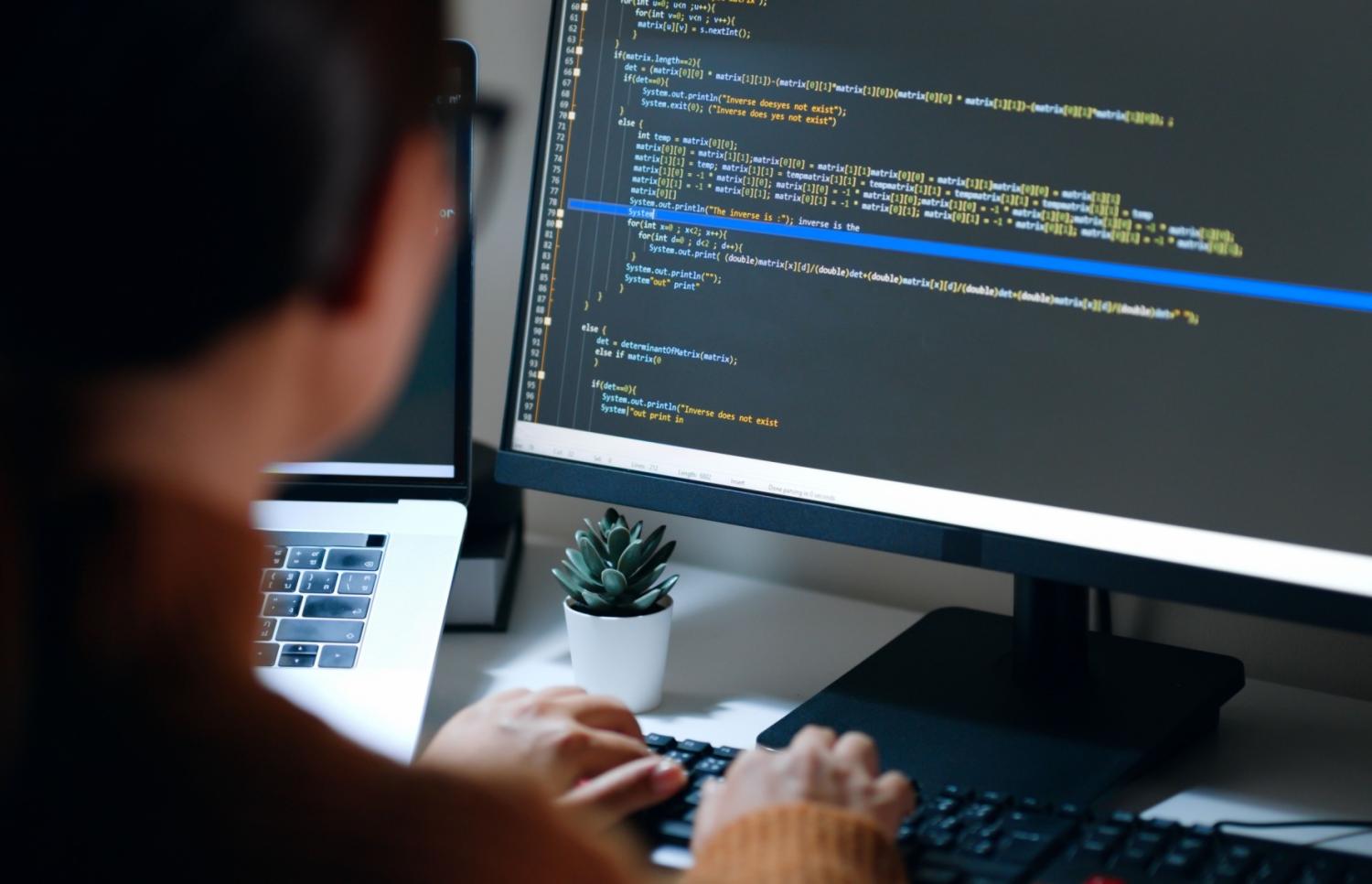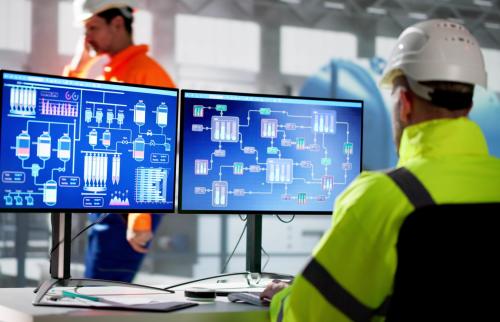This piece draws in part from past research published by the authors in Technology, Productivity, and Economic Growth and the Journal of Financial Economics
The past decade has seen tremendous growth in commercial investments in artificial intelligence (AI). The first wave came after the 2012 ImageNet challenge, which was a pivotal moment in the history of artificial intelligence, particularly computer vision and deep learning. Then, advances in computing power—GPU hardware—powered neural network models trained on large amounts of data. Across industries, from construction to pharmaceuticals to finance, companies rushed to implement AI in their operations. This trend has only accelerated with the release of OpenAI’s ChatGPT in late 2022. Even larger models trained on even larger datasets are showing even greater power, and AI applications are becoming ubiquitous across U.S. businesses (Babina, et al. 2024).
The rapid rise of commercial AI has inevitably brought concerns regarding its potential to displace human workers. There is evidence that AI can automate some cognitive tasks or increase worker productivity in a way that could reduce the number of workers needed. For example, Brynjolfsson, et al. (2025) find that AI tools make customer service workers much more efficient. Fedyk, et al. (2022) find that audit firms that use AI reduce their audit workforce. But the good news is that the labor-displacing effects seem confined to select sectors and occupations. On aggregate, recent academic research finds evidence that companies’ use of AI has been accompanied by an increase in the workforce.
This article synthesizes recent research—including new findings from Babina, et al. (2024) and Babina, et al. (2023)—to assess the real-world impacts of AI on firms and workers. Contrary to common fears, we find that AI has so far not led to widespread job loss. Instead, AI adoption is associated with firm growth, increased employment, and heightened innovation, particularly in product development. However, the effects are not uniformly distributed: AI-investing firms increasingly seek more educated and technically skilled employees, alter their internal hierarchies, and contribute to rising industry concentration. These trends carry important implications for public policy, including workforce development, education and reskilling initiatives, and antitrust enforcement. This article reviews the evidence and highlights key takeaways for policymakers navigating the AI-driven economy.
AI has spurred firm growth—and increased employment
Babina, et al. (2024) leverage detailed data on job postings and individual employees, covering as much as 64% of the U.S. workforce, to track individual companies’ investments in artificial intelligence and the accompanying changes in firms’ operations and workforces. The approach builds on the heavy reliance of AI implementation on skilled AI workers to measure firm-level AI investments by tracking AI researchers and software engineers. This method enables investigation of firm-level effects of AI investments, which was previously lacking. Most prior work focused on the effects of AI on occupations or industries due to the dearth of firm-level data. Exceptions include studies such as Alderucci, et al. (2019), which look at AI patents. This approach is great for identifying firms that are producing AI tools but is less suitable to capture all firms using AI in their everyday operations.
The method to measure firm-level AI investments proceeds in three steps. First, job postings can be used to identify the skills and terms that are related to AI. Starting with the set of general, core AI skills (“artificial intelligence,” “machine learning,” “natural language processing,” and “computer vision”), every required skill from the job postings is assigned a score based on its co-occurrence with these core AI skills. For example, the skill “Tensorflow” has a value of 0.9, which means that 90% of job postings with Tensorflow as a required skill also require one of the core AI skills or contain one of the core AI skills in the job title. Hence, a “Tensorflow” requirement in a job posting is highly indicative of that job being AI-related. On the other hand, the AI-relatedness measure of the skill “Snow Removal” is literally zero. Having identified the most AI-relevant terms, the second step is to search for them in the resume data. If someone has a job title of “Machine Learning Engineer” or a patent in “deep learning” they are likely implementing AI as their job. The final step is to aggregate the measure up to the firm level. What percentage of the employees at a given firm in a given year are AI workers? This percentage will be very low at all firms—AI workers are highly specialized labor, about as frequent as patent-holding inventors. But for some firms this percentage will be 0 (these firms are not investing in AI), whereas for other firms it may be a full 1% (these firms have a dedicated AI team). The difference in the increase in the share of AI workers from 2010 to 2018 gives a consistent measure of the extent to which different firms invested in artificial intelligence during the period when AI emerged as commercially valuable technology.
The measure of firm-level investments in artificial intelligence shows a striking positive relationship with firm growth. A one-standard-deviation difference in AI investments has translated—over the course of a decade—into around a 20% difference in sales growth. That’s roughly 2% additional sales growth per year. Looking at the timing of the effects, they are typically not immediate. It takes approximately two to three years for firms’ AI investments to trickle down to increased sales, but after that initial ramp up period, there is a persistent increase. This delay between investment in a new technology and ultimate performance improvements is not surprising given what we know from the history of new technologies. As described in Brynjolfsson, et al. (2019), it typically takes time for firms to invest in the necessary complementary assets needed to take advantage of the new technology.
Given popular press concern about the link between AI and jobs, a perhaps even more surprising finding is that the growth in sales has been accompanied by similar growth in employment. Firms that invested more in AI actually increased their total employee headcount. Similar to sales, employment growth begins to show up approximately two to three years after AI investments and remains elevated thereafter. In terms of magnitude, growth in employment is similar to growth in sales: an extra 2% per year per one-standard-deviation increase in AI investment. This also shows up in costs: Both costs of goods sold and operating expenses increase roughly proportionally to sales as companies invest in AI.
As a result, productivity measures have not moved much on aggregate over the past decade of increasing AI investments. Several papers examining the effects of AI have found strong evidence of increased growth in firm sales, coupled with null effects on productivity. For example, Rock (2019) and Babina, et al. (2024) find that AI investments have not been associated with increases in either sales per worker or revenue total factor productivity.
Thus, it does not appear to be the case that the main use of AI so far has been to cut costs and replace human workers. This may be relevant in certain specific sectors, such as audit, where artificial intelligence is especially well-suited to the task and where there might not be much potential to innovate and grow. But in most sectors, the primary effect of AI on firms is through sales growth and expansion.
AI-fueled growth has come from innovation
It appears that AI-fueled growth is coming from increased product innovation. Over the course of 2010-2018, we find that a one-standard-deviation increase in firm-level AI investments has been associated with a 13% increase in trademarks and a 24% increase in product patents. Both effects are statistically significant. In contrast, process patents go up by just over 1%, and the effect is not statistically significant. This finding is consistent with firms using AI predominantly to innovate in the product space, rather than for process innovation and improved efficiency.
AI-powered innovation includes both incremental changes such as improving products and breakthrough innovations such as completely new product creation. For example, computer vision that makes cars “see” makes them safer, improving car quality. In terms of breakthrough innovations, the leadership of Moderna highlighted advances in machine learning and AI as being the driving force behind the firm’s ability to very rapidly create a vaccine against COVID-19. Experimentation processes that would have previously taken years can happen in a matter of months due to the new prediction technology.
Workforce upskilling when firms adopt AI
AI-fueled innovation means that the overall relationship between commercial adoption of AI and employment has been positive. But does this mean that there is no reason for workers to worry about their jobs? Not quite. What the granular employer-employee data show is a more nuanced picture. While overall employment has increased at AI-investing firms, the composition of those firms’ workforces has also changed.
Babina, et al. (2023) show that as firms invest in AI they start tilting their workforces towards (i) more educated workers, (ii) more technically skilled workers, and (iii) more independent contributors. Over the course of eight years, a one-standard-deviation increase in firm-level AI investment has been associated with a 3.7% increase in the share of college-educated workers, a 2.9% increase in the share of workers with master’s degrees, and a 0.6% increase in the share of workers with doctoral degrees. Correspondingly, the share of workers without a college degree has declined by 7.2%.
Since total employment went up, this does not necessarily mean that firms fired non-college-educated workers. But there has been a substantial reallocation in terms of new hiring, with AI-investing firms looking for an increasingly educated workforce. Furthermore, AI-investing firms are also looking for different types of education: The share of employees whose most recent degree was in a STEM field has increased in firms investing in AI, while the relative share of other types of majors (social science, arts, medicine, etc.) has correspondingly declined.
This is one way in which AI is similar to prior technologies—it is a skill-biased technological change favoring higher-skilled workers (Autor, et al. 1998; Autor, et al. 2003; Acemoglu and Autor 2011; Katz and Murphy 1992). The fact that firms’ AI investments favor higher-skilled workers highlights the importance of reskilling, which allows the workforce to keep pace with new technological advances.
Changes in firms’ hierarchical structure
Interestingly, when we look at the hierarchical structure of firms’ workforces, we see that AI investments are associated with increased hiring of independent, deputized workers and decreased hiring of top and middle management positions. This empirical finding is not obvious ex ante. On the one hand, increased product innovation spurred by firms’ AI investments can lead to a larger, more complex firm structure that would require greater management. On the other hand, firms’ investments in AI can reduce the costs of accessing knowledge through reduced data processing, resulting in increased problem-solving ability of individual employees at all levels. Garicano and Rossi-Hansberg (2006) suggest that this can lead to increased span of control of individual employees and less reliance on top-heavy hierarchical structures. In their model, technology that improves knowledge acquisition is an equalizing force across employees.
Using detailed resume data, Babina, et al. (2023) find that a one-standard-deviation increase in firms’ AI investments from 2010 to 2018 is associated with a 1.6% increase in the share of junior employees (i.e., any employees not managing others—either entry-level employees or more experienced single contributors). Correspondingly, AI-investing firms have experienced a 0.8% decrease in the share of middle managers (i.e., team leads or managers with a cluster of teams under them) and a 0.7% decrease in the share of senior management (i.e., division heads and firm-level management including the C-Suite). Importantly, there was no contemporaneous trend towards more bottom-heavy hierarchical structures: The shares of junior employees, mid-level management, and senior management remained more or less flat across U.S. public firms from 2010 to 2018. The differential tilt towards less top-heavy hierarchical structures seems to be unique to AI-investing firms.
Overall, investments in AI are associated with major changes in firms’ labor composition and organization, translating into a broader shift toward more junior employees with high educational attainment and technical expertise. The shifts in hierarchical structure and employees’ technical education go hand in hand with each other. Caroli and Van Reenen (2001) point out the complementarity between organizational change and employee skills. The flattening of hierarchical structures requires higher human capital from each individual employee. This is what appears to be happening with AI. Greater access to this technology empowers highly skilled employees to innovate and achieve more. By deputizing these employees, the firm becomes less reliant on heavy management layers.
Effects from artificial intelligence on US industries
Artificial intelligence has already brought about significant changes to firm operations and workforces. But what has been the net effect on U.S. industries? Have firms that invested more in AI benefited at the expense of their competitors? Or has AI been a generally uplifting trend?
There are a few ways we can think about the broader, industry-level effects of AI. The first is to look at what happens to industry-level sales and employment. This is the most immediate way to see whether the benefits from a new technology such as AI aggregate up or if it’s purely a reallocation effect—where some firms benefit by grabbing revenues away from other firms. For some prior technologies, including robotics, there is evidence that suggests a reallocation effect. For example, Acemoglu, et al. (2020) find that investments in robots are associated with increases in firm-level employment but decreases in industry-level employment. That is, some firms automate their workforces, become more efficient, grab market share from their competitors, grow, and hire more workers—but the concentration of activity in the automating firm means that aggregate employment falls at the industry level.
To date, there has been no evidence of a displacement effect from AI at the industry level. Babina, et al. (2024) examine how AI investments at the industry level (i.e., the increase in the share of AI workers in an industry) relate to industry-level growth in sales and employment. Both industry-level sales and industry-level employment increase with AI, at least in the sample of publicly traded (Compustat) firms. Looking at total industry employment (including non-publicly traded firms) shows milder growth, suggesting that there is some reallocation from smaller, private firms to larger, publicly traded firms. But the reallocation effect does not dominate, and on net there is weakly positive growth in total industry employment.
The second way to look at the industry-level trends is to consider the distributional effects between firms. While industry-level growth is good news, the distributional effects can shed light on potential concerns such as increased concentration and decreased competition. And indeed, investments in artificial intelligence do not generate the same kind of benefits for all firms. Larger firms, which have extensive proprietary data and more resources to invest in bespoke AI models, can reap greater benefits from their AI investments.
Babina, et al. (2024) slice the sample of Compustat firms into terciles based on initial firm size measured as of 2010. They then examine the effect of AI investments—that is, differential growth between firms that invest more in AI versus those that invest less—separately within each tercile. The results show that the effect of AI has been most pronounced in the top tercile of firms (i.e., the largest firms). The effect of AI has been milder but still significant in the middle tercile of firms. But the beneficial effect of AI has been statistically insignificant and economically small when we look at the lowest tercile of firms based on firm size. This means that among smaller firms, there has been virtually no difference between those firms that invested in AI and those that did not.
At the industry level, this means that AI investments are associated with increased industry concentration. There are different ways to measure concentration: the share of sales that goes to the single largest firm in an industry and the Herfindahl-Hirschman Index. Both of these measures have increased in industries that invest more in artificial intelligence. Thus, AI investments appear to be generally beneficial for industry growth, but they also lead to increased concentration, whereby the largest firms benefit the most and grow even larger.
Is this increase in concentration a cause for concern? Some might worry that an industry dominated by a few large firms leads to higher prices for consumers. We do not know yet. Firms’ AI investments have not been associated with increased markups yet. But it’s not implausible that firms investing in AI first focus on growth through innovation and new product creation and then later take advantage of their greater market dominance by increasing prices. Potential for decreased competition is one area where policy should remain flexible and responsive to future incoming data. But so far, AI has brought positive effects for U.S. firms and industries without decreasing employment—and that is good news.
Policy implications
The rapid diffusion of AI across firms has already begun to reshape labor markets, organizational structures, and industry dynamics. While the evidence to date is largely positive—pointing to growth in firm sales, employment, and innovation—these benefits have accrued disproportionately to larger, better-resourced firms and more highly educated workers. As a result, AI adoption is contributing to increased industry concentration and a more skill-biased labor market. Policymakers should prepare for these structural changes by investing in education and workforce development programs that emphasize STEM and digital skills, supporting mid-career reskilling for displaced workers, and monitoring the competitive dynamics of increasingly AI-driven industries.
In parallel, expanding access to data through frameworks like open banking or open data can help level the playing field for smaller firms that lack the proprietary data resources of their larger competitors. Indeed, evidence from Babina et al. (2025) shows that open banking policies, which allow bank customers to share their financial data from their bank with financial technology services (fintechs), have led to increased fintech entry and innovation, potentially counteracting the monopoly power of incumbent banks stemming from their proprietary data. A forward-looking policy approach will be essential to ensure that the benefits of AI adoption are widely shared and that innovation continues to enhance, rather than erode, equitable economic growth.
-
References
Acemoglu, Daron, and David Autor. 2011. “Skills, Tasks and Technologies: Implications for Employment and Earnings.” In Handbook of Labor Economics, 4:1043–1171. Elsevier. https://doi.org/10.1016/S0169-7218(11)02410-5.
Acemoglu, Daron, Claire Lelarge, and Pascual Restrepo. 2020. “Competing with Robots: Firm-Level Evidence from France.” AEA Papers and Proceedings 110 (May): 383–88. https://doi.org/10.1257/pandp.20201003.
Alderucci, Dean, Sagar V. Baviskar, Lee G. Branstetter, Nathan Goldschlag, Eduard Hovy, Andrew Runge, Prasanna Tambe, and Nikolas Zolas. 2019. “Quantifying the Impact of AI on Productivity and Labor Demand: Evidence from U.S. Census Microdata.” In . Cambridge, MA. https://www.semanticscholar.org/paper/Quantifying-the-Impact-of-AI-on-Productivity-and-1-Alderucci-Branstetter/49d415cf593be38c6cd97a183dadc7d7b48bab72.
Autor, D. H., L. F. Katz, and A. B. Krueger. 1998. “Computing Inequality: Have Computers Changed the Labor Market?” The Quarterly Journal of Economics 113 (4): 1169–1213. https://doi.org/10.1162/003355398555874.
Autor, D. H., F. Levy, and R. J. Murnane. 2003. “The Skill Content of Recent Technological Change: An Empirical Exploration.” The Quarterly Journal of Economics 118 (4): 1279–1333. https://doi.org/10.1162/003355303322552801.
Babina, Tania, Saleem Bahaj, Greg Buchak, Filippo De Marco, Angus Foulis, Will Gornall, Francesco Mazzola, and Tong Yu. 2025. “Customer Data Access and Fintech Entry: Early Evidence from Open Banking.” Journal of Financial Economics 169 (July): 103950. https://doi.org/10.1016/j.jfineco.2024.103950.
Babina, Tania, Anastassia Fedyk, Alex He, and James Hodson. 2024. “Artificial Intelligence, Firm Growth, and Product Innovation.” Journal of Financial Economics 151 (January): 103745. https://doi.org/10.1016/j.jfineco.2023.103745.
Babina, Tania, Anastassia Fedyk, Alex X. He, and James Hodson. 2023. “Firm Investments in Artificial Intelligence Technologies and Changes in Workforce Composition.” In Technology, Productivity, and Economic Growth. University of Chicago Press. https://www.nber.org/books-and-chapters/technology-productivity-and-economic-growth/firm-investments-artificial-intelligence-technologies-and-changes-workforce-composition.
Brynjolfsson, Erik, Danielle Li, and Lindsey Raymond. 2025. “Generative AI at Work.” The Quarterly Journal of Economics 140 (2): 889–942. https://doi.org/10.1093/qje/qjae044.
Brynjolfsson, Erik, Daniel Rock, and Chad Syverson. 2019. “1. Artificial Intelligence and the Modern Productivity Paradox: A Clash of Expectations and Statistics.” In The Economics of Artificial Intelligence: An Agenda, edited by Ajay Agrawal, Joshua Gans, and Avi Goldfarb, 23–60. University of Chicago Press. https://doi.org/10.7208/9780226613475-003.
Caroli, E., and J. Van Reenen. 2001. “Skill-Biased Organizational Change? Evidence from A Panel of British and French Establishments.” The Quarterly Journal of Economics 116 (4): 1449–92. https://doi.org/10.1162/003355301753265624.
Fedyk, Anastassia, James Hodson, Natalya Khimich, and Tatiana Fedyk. 2022. “Is Artificial Intelligence Improving the Audit Process?” Review of Accounting Studies 27 (3): 938–85. https://doi.org/10.1007/s11142-022-09697-x.
Garicano, L., and E. Rossi-Hansberg. 2006. “Organization and Inequality in a Knowledge Economy.” The Quarterly Journal of Economics 121 (4): 1383–1435. https://doi.org/10.1093/qje/121.4.1383.
Katz, L. F., and K. M. Murphy. 1992. “Changes in Relative Wages, 1963-1987: Supply and Demand Factors.” The Quarterly Journal of Economics 107 (1): 35–78. https://doi.org/10.2307/2118323.
Rock, Daniel. 2019. “Engineering Value: The Returns to Technological Talent and Investments in Artificial Intelligence.” SSRN Electronic Journal. https://doi.org/10.2139/ssrn.3427412.
The Brookings Institution is committed to quality, independence, and impact.
We are supported by a diverse array of funders. In line with our values and policies, each Brookings publication represents the sole views of its author(s).







